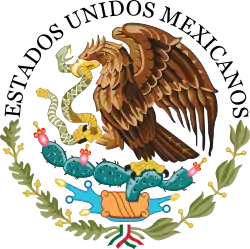Vicente Fox
Vicente Fox Quesada GCMG CYC (American Spanish: [biˈsente ˈfoks keˈsaða]; born 2 July 1942) is a Mexican businessman and politician who served as the 62nd President of Mexico from 1 December 2000 to 30 November 2006.
Vicente Fox | |
|---|---|
.jpg.webp) Official Photo, 2000 | |
| 62nd President of Mexico | |
| In office 1 December 2000 – 30 November 2006 | |
| Preceded by | Ernesto Zedillo |
| Succeeded by | Felipe Calderón |
| Governor of Guanajuato | |
| In office 25 September 1995 – 25 September 1999 | |
| Preceded by | Carlos Medina Plascencia |
| Succeeded by | Ramón Martín Huerta |
| Member of the Chamber of Deputies for Guanajuato's 3rd district | |
| In office 1 September 1988 – 31 August 1991 | |
| Preceded by | Héctor Hugo Varela Flores |
| Succeeded by | Luis Arturo Torres del Valle |
| Co–President of Centrist Democrat International | |
| Assumed office 1 December 2006 | |
| Preceded by | Pier Ferdinando Casini |
| Personal details | |
| Born | Vicente Fox Quesada 2 July 1942 León, Guanajuato, Mexico |
| Political party | Independent (since 2013) National Action Party (before 2013) |
| Spouse(s) | Lilian de la Concha
(m. 1969; div. 1990) |
| Children | Ana Cristina Fox Rodrigo Fox Paulina Fox Vicente Fox, Jr. |
| Parents | José Luis Fox Mercedes Quesada |
| Education | Universidad Iberoamericana (BBA) |
| Occupation | Businessman and politician |
| Signature |  |
Campaigning as a right-wing populist,[1][2][3][4] Fox ran for and was elected president on the National Action Party (PAN) ticket, becoming the first president not from the Institutional Revolutionary Party (PRI) since 1929. He is currently the Co-President of the Centrist Democrat International, an international organization of center-right political parties.[5]
Fox was elected President of Mexico in the 2000 presidential election, a historically significant election since it made him the first president elected from an opposition party since the election of Francisco I. Madero in 1910. Fox finished in first place with 42 percent of the vote.[6]
As president, he mostly followed the neoliberal economic policies that his predecessors from the PRI had adopted since the late 1980s.[7] The first half of his administration saw a further shift of the Federal government to the right,[1][2] strong relations with the United States and George W. Bush,[8] unsuccessful attempts to apply a value-added tax to medicines and to build an airport in Texcoco,[9][10] and a major diplomatic conflict with Cuban leader Fidel Castro.[11] The murder of human rights lawyer Digna Ochoa in 2001 called into question the Fox administration's commitment to breaking with the authoritarian past of the PRI era.
The second half of his administration was marked by his conflict with Andrés Manuel López Obrador, then Mexico City's Mayor. The PAN and the Fox administration unsuccessfully attempted to remove López Obrador from office and to prevent him from participating in the 2006 presidential elections.[12][13] The Fox administration also became embroiled with diplomatic conflicts with Venezuela and Bolivia after supporting the creation of the Free Trade Area of the Americas, which was opposed by those two countries.[14][15] His last year in office oversaw the controversial 2006 elections, where the PAN candidate Felipe Calderón was declared winner by a very narrow margin over his opponent López Obrador,[16] who claimed that the elections were rigged and refused to recognize the results, calling for protests across the country.[17] In the same year, the southern state of Oaxaca was the scene of a teacher's strike which culminated into protests and violent clashes asking for the resignation of governor Ulises Ruiz Ortiz.[18]
On the other hand, Fox was credited with maintaining economic growth during his administration, and reducing the poverty rate from 43.7% in 2000 to 35.6% in 2006.[19]
After serving as president of Mexico for six years, Fox returned to his home state of Guanajuato, where he now resides with his wife and family. Since leaving the presidency, Fox has been involved in public speaking and the development of the Vicente Fox Center of Studies, Library and Museum.[20]
Fox was expelled from the PAN in 2013, after having endorsed the PRI presidential candidate, Enrique Peña Nieto, in the 2012 elections.[21] In the 2018 election Fox again endorsed the PRI's candidate, José Antonio Meade.[22]
Early years
Vicente Fox was born on 2 July 1942 in Mexico City, the second of nine children. His father, José Luis Fox Pont, was a Mexican of German, French and Spanish descent. His mother, Mercedes Quesada Etxaide, was a Basque immigrant from San Sebastián, Gipuzkoa, in Spain.
Previously, many had speculated that Fox was of Irish descent, but it was discovered that Vicente's grandfather was born Joseph Louis Fuchs in Cincinnati, Ohio, and was the son of German Catholic immigrants, Louis Fuchs and Catherina Elisabetha Flach, of Strasbourg, now in France.[23] In the 1870s, the "Fuchs" surname was changed from German to its English equivalent, "Fox".[24] The family was unaware of its German origins and they believed the Fox family had their origins in Ireland.
Fox spent his childhood and adolescence at the family ranch in San Francisco del Rincón in Guanajuato. He spent a year at Campion High School in Prairie du Chien, Wisconsin where he learned English.[25] Upon reaching college age, Fox moved to Mexico City to attend the Universidad Iberoamericana and received a bachelor's degree in business administration in 1964. Then in 1974, Fox received a certificate in management skills from Harvard Business School.[26][27][28]
Business career

In 1964, Fox was hired by the Coca-Cola Company as a route supervisor and drove a delivery truck. After nine years, he had risen to the top, serving as the President and Chief Executive of Coca-Cola Mexico; after six years in this role, he was invited to lead all of Coca-Cola's operations in Latin America, but Fox declined and later resigned from Coca-Cola in 1979.[29] It was during the Fox's leadership of Coca-Cola Mexico that Coke became Mexico's top-selling soft drink, increasing Coca-Cola's sales by almost 50%.[30]
After retiring from Coca-Cola, Fox began to participate in various public activities in Guanajuato, where he created the "Patronato de la Casa Cuna Amigo Daniel", an orphanage. He was also the president of the Patronato Loyola, a sponsor of the León campus of the Universidad Iberoamericana and of the Lux Institute.[31]
Family life
In 1969, Fox married Lilian de la Concha, a receptionist at Coca-Cola.[32] They had four children, Ana Cristina, Vicente, Paulina and Rodrigo.[33] In 1990, after 20 years of marriage, Lilian filed for and was granted a divorce.
Fox remarried on 2 July 2001, while serving as President of Mexico, to Marta María Sahagún Jiménez (until then his spokesperson). The wedding date was the first anniversary of his presidential election and his 59th birthday. For both Fox and Sahagún Jiménez, it was their second marriage.
Early political career
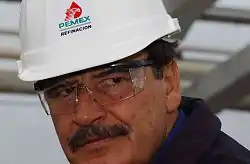
With the support of Manuel Clouthier, Vicente Fox joined the Partido Acción Nacional on 1 March 1988. That same year, he was elected to the federal Chamber of Deputies, representing the Third Federal District in León, Guanajuato.[31]
Governor of Guanajuato
In 1991, after serving in the Chamber of Deputies, Fox sought the governorship in Guanajuato, but lost the election to Ramón Aguirre Velázquez of the PRI. Following the election, local discontent was so great that the state congress appointed Carlos Medina Plascencia of the PAN as interim governor.[34] Four years later, Fox ran again, this time winning by a vote of 2 to 1.[31] As governor, Fox promoted government efficiency and transparency. He was one of the first state governors of Mexico to give a clear, public and timely account of the finances of his state.[35]
Fox also pushed for the consolidation of small firms, promoted the overseas sales of goods manufactured in Guanajuato, and created an extensive system of small loans to allow the poor to open a changaro (a small shop) and buy a car and a television.[36] Under Fox, Guanajuato became the fifth most important Mexican state economy.[35]
Campaign for President

On 7 July 1997, after the opposition parties first won a majority in the Chamber of Deputies, Vicente Fox decided to run for President of Mexico. In spite of opposition within his political party, Fox secured his candidacy representing the Alliance for Change, a political coalition formed by the National Action Party and the Green Ecological Party of Mexico on 14 November 1999.[37]
During the course of his campaign, a presidential debate was organized, but the three main contenders (Fox, Francisco Labastida of the PRI, and Cuauhtémoc Cárdenas of the PRD) disagreed on the details. One notable disagreement, which was broadcast on national television, was whether the presidential debate should be held that same day or on the following Friday.[38]
During the nationally televised presidential debate, Fox's main opponent, Francisco Labastida, claimed that Fox had repeatedly called him a "sissy" and a "cross-dresser" ("La vestida", a pun on his last name).[39] Fox's campaign slogans were "¡Ya!" ("Right now!"), "Ya ganamos" ("We've already won"), and "Vota Alianza por el Cambio" ("Vote for Alliance for Change").
In addition to some debate controversies, Fox also faced some controversy due to Amigos de Fox (Friends of Fox), a non-profit fundraising group established by Denise Montaño. The group was instrumental in getting Vicente Fox elected President of Mexico, and the phrase "Amigos de Fox" was also used as a campaign slogan referring to the millions of people supporting Fox in the 2000 presidential election.[40]
In 2003, money-laundering charges were lodged against Amigos de Fox, but were dropped shortly before the July 2003 mid-term elections.[41]
Election results

On 2 July 2000, his 58th birthday, Fox won the presidential election with 43% (15,989,636 votes) of the popular vote, followed by the Institutional Revolutionary Party (PRI) candidate Francisco Labastida with 36% (13,579,718 votes), and Cuauhtémoc Cárdenas of the Party of the Democratic Revolution (PRD) with 17% (6,256,780 votes). Fox declared victory that same night, a victory which was ratified by then-President Zedillo. After the final results were announced, President-elect Fox addressed thousands of supporters and celebrated his victory with them at the Angel of Independence monument in Mexico City. His opponents conceded the election later that night.
After securing the election, Fox received a substantial amount of media coverage, as well as numerous congratulatory messages and phone calls from world leaders, including then-President of the United States Bill Clinton. He took office as president on 1 December 2000, marking the first time since 1917 that an opposition candidate had taken power from the long reigning Institutional Revolutionary Party (PRI)[42]
Presidency
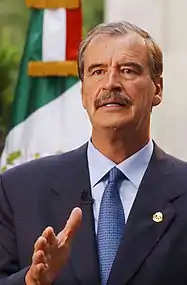
- See article Fox administration
Public image
During his campaign for president, Vicente Fox became well known for his cowboy style and quirkiness. As a speaker, Fox usually attracted big crowds in the early years of his presidency.[43] At 193 cm (6 ft 4 in), Fox easily stood out in most crowds, and is believed to be one of the tallest presidents in Mexico's history.[44] After his inauguration, President Fox usually wore suits for formal occasions, but opted to wear his signature boots and jeans during his many visits around Mexico.[45]
Fox spread his image as one of peace and welcomed many to his own ranch in Guanajuato, Mexico. When Fox welcomed U.S. President George W. Bush to the ranch, both presidents were wearing Fox's signature black cowboy boots, prompting The Wall Street Journal to call it "The Boot Summit".[46]
Approval ratings
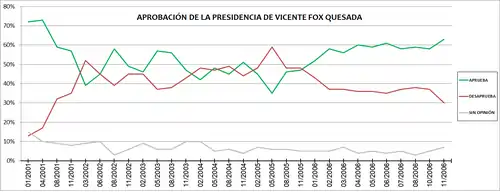
When Fox took office on 1 December 2000, his approval rating neared 80%. During the rest of his presidency, his average approval rating was of 53%, while his average disapproval rating was of 40%.
As seen in the graphic, after taking office the particularly high points of his approval ratings were:
- August 2002 (58% approval, 39% disapproval, 3% unsure), after Fox accepted to suspend the construction of a new airport in the State of Mexico, which had led to months of protests by local residents who resisted their displacement.[47]
- May 2003 (57% approval, 37% disapproval, 6% unsure), after Fox announced that Mexico would not support the US invasion of Iraq.[48]
- Through out 2006, his approval rating in average was 58% and his average disapproval rating was of 37%, as Fox was on his last year as president and the public focus was on the Presidential elections of that year. The popularity enjoyed by Fox during this period, however, didn't seem to largely benefit the Presidential candidate of his party (PAN) Felipe Calderón, who was controversially declared winner with only 35.9% of the votes, against Andrés Manuel López Obrador of the PRD who officially obtained 35.3% of the votes and claimed that the election had been fraudulent.
While the lowest points of his approval ratings were:
- March 2002 (39% approval, 52% disapproval, 9% unsure), in the wake of the "Comes y te vas" ("Eat and then leave") scandal: during the United Nations International Conference on Financing for Development, which took place between 18 and 22 March 2002 in the city of Monterrey and was hosted by Fox, a diplomatic incident occurred when on the night of the 19th Fox received a letter from Cuban leader Fidel Castro informing him that Castro intended to attend the event on the 21st, as he had been invited by the United Nations. Hours after receiving the letter, Fox made a telephone call to Castro in which he expressed his surprise at Castro's intention to attend the conference and scolded him for not telling him earlier. During the call, Fox suggested to Castro that he and the Cuban delegation arrive on the 21st as scheduled to make their presentation, and finally attend a lunch with the other leaders, after which they would return to Cuba. Fox was apparently worried that US President George W. Bush, who was also scheduled to arrive on the 21st,[49] would be offended by Castro's presence at the conference, which is why Fox suggested Castro to leave after the lunch. Castro was outraged at the proposal, and told Fox that in response, he would make the contents of the call -which he was secretly taping- public, which he indeed did. The media quickly caught onto the incident, dubbing it "Comes y te vas" ("Eat and then leave") after Fox's suggestion towards Castro to leave the conference after the aforementioned lunch. The scandal badly hurt the Fox administration, as it made him seem subservient to the United States and it also broke with the Mexican diplomatic tradition of neutrality towards Cuba.[50][51]
- February 2004 (42% approval, 48% disapproval, 10% unsure), in the midst of scandals surrounding the First Lady Marta Sahagún, who was accused by an article in the Financial Times of using public funds to run her "Vamos México" foundation. In the same month, Sahagún announced that she intended to become the PAN candidate for the 2006 Presidential elections, an announcement that was deeply unpopular within the party.[52][53]
- Throughout the rest of 2004 and 2005, Fox's approval rating on average was 45% and his average disapproval rate was of 49%. His generalized descent in popularity during this period is attributed to the highly controversial process of Desafuero against Andrés Manuel López Obrador beginning in May 2004, when the Attorney General of the Republic, supported by the Federal Government, accused López Obrador, then Mayor of Mexico City, of disobeying a federal judge's order regarding an expropriation case, and requested both the removal (desafuero) of López Obrador's constitutional legal immunity and his destitution as Mayor of Mexico City. Due to López Obrador's very high approval ratings in Mexico City[54] and the fact that Fox himself had harshly criticized his administration on previous occasions, López Obrador's supporters protested the desafuero process and accused Fox of trying to prevent López Obrador to participate in the 2006 Presidential elections (given that if he was officially charged, López Obrador would have lost all of his civil rights, including the right to run for the Presidency in 2006, unless he was either quickly acquitted of all charges or managed to serve his sentence before the electoral registration deadline). The process went on for 12 months, and was nearly unanimously criticized by national and foreign media,[55][56] climaxing in April 2005. On 7 April, the Chamber of Deputies voted by 360 to 127 (with two abstentions) to lift López Obrador's constitutional immunity; nonetheless, after a massive rally in support of López Obrador took place in Mexico City on 24 April 2005, with an attendance exceeding one million people (at the time, the biggest political manifestation in recent Mexican history)[57] Fox decided to stop the judicial process against López Obrador.
- May 2005 registered the lowest approval rating for Fox (35% approval, 59% disapproval, 6% unsure) in the aftermath of both the chaotic Desafuero process and the controversial comments made by Fox regarding African Americans that same month.
Controversial comments


- In March 2002, two days prior to the International Conference on Financing for Development held in Monterrey, Nuevo León, Fox called Cuban President Fidel Castro and instructed him to limit his comments about the United States and suggested that Castro leave Mexico after he delivered his speech and ate his meal. Castro later called this a "despicable betrayal."[58]
- In May 2005, a controversy arose over comments Fox made during a meeting with Texas business people in which he said, "There is no doubt that Mexicans, filled with dignity, willingness and ability to work, are doing jobs that not even blacks want to do there in the United States." This angered African-Americans in the United States, prompting many black leaders to demand an apology from Fox. Reverend Al Sharpton requested a formal apology from Fox to the African-American community and called for an economic boycott of Mexican products until an apology was received. Sharpton, along with many African-Americans felt that Fox's comments were insensitive and racist. Reverend Jesse Jackson, during a news conference concerning Fox's statement about African-Americans, said that he felt that the comments were, "unwitting, unnecessary and inappropriate," and added that "[Fox's] statement had the impact of being inciting and divisive."[59]
- Fox was also known to have mispronounced the name of Argentine writer Jorge Luis Borges as "José Luis Borgues" in the Royal Congress of the Spanish Language. This error sparked accusations of an "uncultured" President.[60]
- On 30 May 2005, President Fox told reporters that the majority of the female homicides in Ciudad Juárez had been resolved and the perpetrators placed behind bars. He went on to criticize the media for "rehashing" the same 300 or 400 murders, and said matters needed to be seen in their "proper dimension."[61][62]
- In 2006, after Bolivian President Evo Morales refused to sell natural gas, Fox said, "Well, they'll either have to consume it all themselves or they're going to have to eat it."[63]
- On 8 March 2006, in the wake of the murder of Canadians Domenico and Nancy Ianiero at a resort in Cancún, Fox said there was evidence that pointed to Canadian suspects from Thunder Bay, in an apparent attempt to portray Cancún as a safe vacation resort. Fox's comments were criticized by the Ianieros' lawyer Edward Greenspan for compromising the investigation, which the Canadian press characterized as mishandled by Mexican authorities.[64] Thereafter, attorney general Bello Melchor Rodríguez later stated that Canadians were never considered as suspects.[65][66]
- In November 2006, the TV network Telemundo released a video of a previously recorded interview with President Fox in which he stated: "Ya hoy hablo libre, ya digo cualquier tontería, ya no importa, ya total, yo ya me voy" which means "Now, I speak freely. Now, I say whatever nonsense. It doesn't matter anymore. Anyway, I'm already leaving." Then, during the interview he talked about the violent situation in Oaxaca. The President's office complained about the release of this footage and said he was not aware of the camera and microphones being turned on. News agency EFE accused Telemundo of acting unethically, because the video was EFE's intellectual property.[67]
- In 2006, Fox decided to cancel the parade commemorating the 96th anniversary of the Mexican Revolution which was scheduled to take place on 20 November, arguing it was an obsolete celebration that nobody wanted to participate in any more. Some commentators considered that this was a response to Andrés Manuel López Obrador's assumption of an alternative presidency to take place the same day. Others considered Fox's move a smart decision, while others viewed it as a sign of political weakness.[68]
- In a lecture in the United States, in which he was a keynote speaker, he identified Peruvian writer Mario Vargas Llosa as a Colombian Nobel laureate (Spanish by naturalization). At the time, however, Vargas Llosa was not a Nobel Laureate.[60] Later, in October 2010, Fox congratulated Vargas Llosa on Twitter for winning the Nobel Prize in Literature, but he incorrectly attributed the Nobel Prize to Jorge Luis Borges.[69]
Legacy and assessment

Although Fox's victory in the 2000 election and the end of seven decades of PRI rule raised great expectations of change among the Mexican people, his administration was criticized for failing to fulfill those expectations, as little progress was made in fighting corruption, crime, poverty, unemployment and inequality. Few key reforms were implemented during the Fox administration, which became characterised by a growing sense of power vacuum as Fox was increasingly perceived by Mexican society and political actors as a "lame duck" incapable of pushing the ambitious reform agenda that swept him into power in 2000.[70][71][72] Alejandro Cacho points out that "Fox incarnated the hope of alternancy [...] and he managed to kick the PRI out of Los Pinos, but his government was a disappointment. Corruption persisted; in fact, his sons-in-law (the Bribiesca-Sahagún brothers) became rich quickly and without explanation. The economy wasn't much better than it had been under Ernesto Zedillo, the wages didn't increase significantly, neither did jobs. His "super cabinet" ["gabinetazo", as Fox himself referred to it] created more controversy than it did good results. His wife, Marta Sahagún, had a big influence in the presidential decisions".[73]
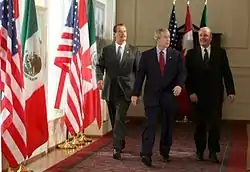
Having assumed office with an approval rating of 80%,[70] by the time he left office in 2006 his public image had become exhausted by the controversial presidential elections of that year and the few reforms implemented.
In terms of the significance of Fox's presidency, historian Philip Russell asserts that, "Marketed on television, Fox made a far better candidate than he did president.[74] He failed to take charge and provide cabinet leadership, failed to set priorities, and turned a blind eye to alliance building." Fox himself asserted in 2001 (one year into his administration) that he much preferred his experience as candidate than actually being president.[73]
Russell also pointed to 2006 comments by political scientist Soledad Loaeza, who noted, "The eager candidate became a reluctant president who avoided tough choices and appeared hesitant and unable to hide the weariness caused by the responsibilities and constraints of the office." Russell also asserted that Fox "had little success in fighting crime. Even though he maintained the macroeconomic stability inherited from his predecessor, economic growth barely exceeded the rate of population increase. Similarly, the lack of fiscal reform left tax collection at a rate similar to that of Haiti . . . ." Finally, Russell noted that "during Fox's administration, only 1.4 million formal-sector jobs were created, leading to massive immigration to the United States and an explosive increase in informal employment." Ultimately, however, Russell concluded that Fox will be viewed by history as a transitional figure who was able to defeat one of Mexico's long-entrenched political parties.[74]
In a national survey conducted in 2012 by BGC-Excelsior regarding former presidents, 32% of the respondents considered that the Fox administration was "very good" or "good", 25% responded that it was an "average" administration, and 42% responded that it was a "very bad" or "bad" administration.[75]
Post-presidential life
Public speaking and advocacy

After leaving office in December 2006, Fox has maintained himself in the public eye by speaking in countries such as Nigeria, Ireland,[76] Canada, and the United States about topics such as the controversial 2006 election and the Iraq War. In Mexico, Fox has been criticized by some for his busy post-presidency since former Mexican presidents are traditionally expected to stay out of the political spotlight. In response, Fox has stated, "There is no reason to hold to the anti-democratic rules of those who still live in the authoritarian past . . . now that Mexico is a democracy, every citizen has the right to express himself, even a former president."[77]
Vicente Fox joined four other Latin American presidents at the One Young World Summit 2014 in Dublin, Ireland,[78] to discuss the Telefónica Millennial Survey. He told those in the audience that eradicating corruption "has to start with education" and that his focus is now on promoting leadership.[79]
Vicente Fox is a member of the Global Leadership Foundation, a not-for-profit organization that offers, discreetly and confidentially, a range of experienced advisors to political leaders facing difficult situations.
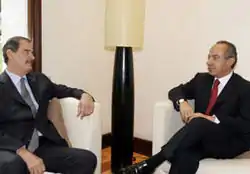
In 2013, Fox discussed why the West has pursued a moral crusade against drugs at HowTheLightGetsIn festival in Hay-on-Wye.[80] with Chris Bryant and John Ralston Saul. The three debated whether it is hypocritical to ban certain drugs while continuing to export others such as alcohol and tobacco, and whether to follow the lead of Washington and Colorado states in the U.S. and allow the free trading of drugs.
Vicente Fox gave a video interview in July 2013 to High Times, in which he discussed the failure of drug prohibition, and cited Portugal's decriminalization policies as "working splendid(ly)." He said he supports drug legalization despite not being a user himself, just as he said he also "fully respects" same-sex marriage although he does not personally agree with it.[81]
In February 2014, Fox wrote an opinion piece that was published in Toronto's The Globe and Mail in which he stated that, "Legalization of not just marijuana, but all drugs, is the right thing to do."[82] He also said that "we must be given the very freedom to decide our own behaviour and to act responsibly, as long as we do not detrimentally affect the rights of others".[82]
In 2016, Fox co-signed a letter to Ban Ki-moon calling for a more humane drug policy.
In July 2017, Fox was an international observer to the unofficial Venezuelan referendum held by the opposition.[83] During the trip, Fox gave a speech that compared the referendum to the 2000 Mexican elections.[84] He said that "this battle has been won" and "step by step, vote by vote, the dictator will leave."[85] He was subsequently declared a persona non grata by the Venezuelan government.[83] Venezuelan Foreign Minister Samuel Moncada said that Fox had taken advantage of the country's hospitality and "was paid to come to Venezuela to promote violence and the intervention of foreign powers."[84] Moncado said the ban came from Maduro and criticized Fox and the other former Latin American leaders invited as observers (Andrés Pastrana, Jorge Quiroga, Laura Chinchilla and Miguel Ángel Rodríguez) as "political sicarios," "clowns" and "mercenaries" that "sell themselves to the highest bidder to go to various destinations and repeat what they are told."[85] Fox said he was not surprised by the ban and that the vote would weaken Maduro.[86]
In 2018, Fox joined the High Times board of directors.[87] He left the board in 2020 over concerns surrounding the company's stock offering. [88]
Criticism of Donald Trump
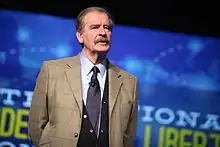
Fox has been an outspoken critic of U.S. President Donald Trump, beginning with Trump's bid for the Republican candidacy in the 2016 presidential election.
In an interview with Univision's Jorge Ramos in February 2016, Fox responded to then-candidate Trump's proposal to build a wall at the border between the United States and Mexico at Mexico's expense,[89] declaring in English, "I am not going to pay for that fucking wall. He should pay for it. He's got the money."[90] Fox went on to call Trump a "crazy guy" and a "false prophet," and questioned the claim that Trump received 44% of the Hispanic vote in the Republican caucus in Nevada.[91] Trump took to Twitter in response, demanding that Fox apologize for using "the F word while discussing the wall."[92] Fox eventually apologized for the remark,[93] while also asking for Trump to apologize for his remarks about Mexicans and inviting Trump to visit Mexico.[93]
Despite his apology, Fox continued to criticize Trump to the international media and troll Trump on Twitter, stating, "I'm committed to be Donald Trump's shadow until he is done with politics."[94] When Trump visited Mexico on 31 August 2016 upon President Enrique Peña Nieto's invitation, Fox slammed the visit, calling it a "desperate move" on the part of Peña Nieto and stating, "He is not welcome in Mexico. We don't like him. We don't want him. We reject his visit."[95] Trump responded by pointing out Fox's previous invitation, to which Fox clarified that he invited Trump to Mexico on the condition that he used the visit to apologize to the Mexican people.[95] He directly addressed the American people the next day on CNN, where he described Trump as a "false prophet" who is "absolutely crazy" and warned that they need to "wake up" and realize the harm that Trump's immigration and economic policies would inflict on the United States.[96]
Later in September 2016, The Washington Post reported that Fox had received multiple emails from Trump's campaign soliciting donations throughout the month.[97] Fox received the first email on 9 September, which he posted on Twitter and responded, "Donald Trump, I won't pay for that fucking wall! Also, campaigning in Mexico? Running out of money and friends?"[98] Fox received two additional emails on 24 and 27 September, both of which he also posted on Twitter and mocked as being "desperate" and "begging."[99][100] The revelation of the emails has raised concern, as accepting campaign donations from foreign nationals is illegal in the United States.[97]
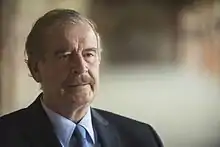
During a September 2016 appearance on the radio show El Show de Piolín, Fox smashed a Trump piñata hanging on the streets of Los Angeles while loudly singing the traditional Piñata song. Upon breaking it open, Fox noted its lack of contents and remarked, "Empty. Totally Empty. He doesn't have any brains."[101] Discussing the event during a subsequent interview with GQ, Fox expanded, "I had such a joy in my heart by doing that, because in Mexico, piñatas are very meaningful. Piñatas are a celebration. Piñatas let you send messages. And the message is: Trump is empty inside. He's empty in his head. That's why I put my hand into his head. There was no brain there. That's what he is, an empty person."[101]
The day after Trump won the election, Fox wrote an editorial on the International Business Times website where he lamented Trump's victory and explored what Mexico could do in response. "Even though Trump is not the prettiest person in the room, we still have to dance with him. Now, we ought to look out for ourselves and find a way to work with the most powerful economy in the world, which is now led by an authoritarian racist[...]Donald Trump's promises have an expiration date. When the time comes to truly deliver to the American people, his "billion dollar show" will finally crumble beneath his feet," Fox wrote, concluding his editorial with, "I find quite sad that America, formerly the most open and cutting edge nation, has chosen to lock itself down inside concrete walls. It's tragic that fear, anger and wrath took over and pierced the hearts of their people. It will be hard to recover from this wound; but we better start working to heal as quickly as possible – and bring down the walls that blinded us in the beginning."[102]
.jpg.webp)
Fox has continued criticizing Trump on Twitter after the election. In a series of tweets in January 2017, Fox again criticized Trump's proposed Mexican border wall, calling it a "racist monument" and insisted that Mexico will never fund it, calling on Trump to "be honest with US taxpayers" about that fact.[103] Following the release of a U.S. government intelligence report that accused Russia of interfering in the 2016 election to ensure Trump's victory, Fox tweeted, "Sr Trump, the intelligence report is devastating. Losing election by more than 3M votes and in addition this. Are you a legitimate president?"[104] Fox further criticized Trump's response to the intelligence report, calling him a "bully" and a "bluff" and stating that Trump is "bringing in a new era of dictatorship."[105] Though on 12 January, Fox broke with his criticism of Trump and simply tweeted, "America Will Survive."[106]
In an interview with Anderson Cooper on 25 January 2017, and during an appearance on Conan O'Brien's late night talk show on 1 March 2017, Fox again asserted that Mexico should not have to pay for the wall.[107]
In September 2017, Fox was once again in the news after President Trump announced he would end the Deferred Action for Childhood Arrivals (DACA) program in six months if the U.S. congress failed to pass legislation to address the issue. In response, Fox tweeted to President Trump's Twitter account, "Ending DACA is on the top of the vilest acts you’ve pulled off. You’re destroying the legacy of greater men before you." In another tweet, Fox suggested that President Trump's DACA decision was a result of him compensating for earlier failures to pass healthcare legislation to replace the Affordable Care Act. Fox then went on to post a video in which he claimed that President Trump had "failed America" and stated that "[t]his measure is cruel and heartless, worse than any machine. You’re cancelling the future of 800,000 children and young people."[108]
As Fox frequently uses Twitter (in English) to respond to tweets by President Trump, he has attracted more than 1 million followers on his Twitter account.[109]
Since May 2017, Fox has appeared in a series of humorous videos seriously denouncing Donald Trump, including "Vicente Fox is Running for President of the United States" (fake announcement for the candidacy) which was released in September.[110]
Autobiography
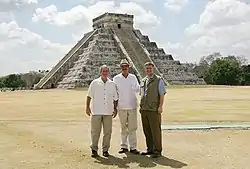
Fox's autobiography, entitled Revolution of Hope: The Life, Faith and Dreams of a Mexican President, was released in September 2007.[111] To promote its release, Fox toured many U.S. cities to do book-signings and interviews with U.S. media. During his tour, however, he faced protests from Mexican immigrants who accused him of actions that forced them to emigrate and find jobs in the United States.[112] He faced the subject several times during interviews, such as one held with Fox News's Bill O'Reilly, who questioned him about the massive illegal immigration problem of Mexicans into the United States.[113] Finally, during an interview with Telemundo's Rubén Luengas, the interviewer asked Fox about allegations concerning some properties of Vicente Fox's wife, Marta Sahagún. After Fox explained the situation, he asked the interviewer not to make false accusations and to prove what he was saying. Luengas said, "I'm telling you in your face, I'm not a liar." After this, Fox walked out of the studio, calling the interviewer a "liar," "vulgar," and "stupid."[114]
Upon the book's release, some readers viewed several excerpts as being highly critical of U.S. President George W. Bush, considered by many to be a close friend. For example, Fox wrote that Bush was "the cockiest guy I have ever met in my life," and claimed that he was surprised that Bush had ever made it to the White House. Later, in an interview with Larry King, Fox explained that this was a misunderstanding and that what he meant by calling George W. Bush "cocky" was to say he was "confident."[115] Fox also referred to Bush in his autobiography as a "windshield cowboy," due to Bush's apparent fear of a horse Fox offered him to ride.[116]
Fox Center of Studies, Library and Museum
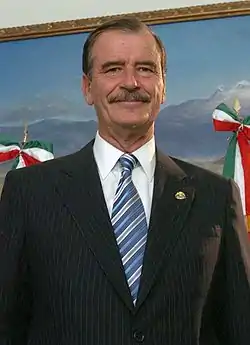

On 12 January 2007,[117] over a month after he left office, Fox announced the construction of a center of studies, library and museum that was labeled by the U.S. press as Mexico's first presidential library.[118][119][120] The project will be a library, museum, a center for the advancement of democracy, a study center and a hotel, and it will be completely privately funded.[121][122] It is expected to be a genuine U.S.-style presidential library. It will be built in Fox's home state of Guanajuato, in his home town of San Francisco del Rincón.
While museums are abundant throughout the country, there is nothing comparable to a presidential library where personal documents, records, and gifts amassed by the country's leader are open to the public. Fox's library will be modeled after the Bill Clinton Library in Little Rock, Arkansas,[123] which, according to the former president, will allow Mexicans to enjoy, for the first time in Mexico's history, a library in which to review the documents, images and records that made up his six years as president.[124]
According to the official website, the construction of the center is in progress and advancing.[125] Final completion of the library was expected by late 2007.
In 2015, Fox was interviewed by Peter High for Forbes at the library, which is called "Centro Fox" (the Fox Center). During the interview, Fox remarked that the guiding principle behind the library is that "[w]e are a Latin American center that is geared around ideas, leadership, and strategies. We do it through, number one, young kids. The middle-upper class and the rest have access to the best universities. But the broader constituency does not receive any messages or aspirations of happiness in life at home."[126]
In addition to the library's completion, there has been some indications that Centro Fox was joining hands with UST Global to transform Mexico into a world-class technological economy.[127] Fox stated in a press release that "UST Global is partnering Centro Fox to help accomplish nothing less than the transformation of my country into a world-class technology economy . . . . Together, we will establish Mexico at the forefront of the information technology revolution in the region." These efforts appear to be ongoing.
Centrist Democratic International
On 20 September 2007, Fox was elected Co-President of the Centrist Democratic International (along with the re-elected Pier Ferdinando Casini) at its leaders' meeting in Rome. The CDI is the international organization of political parties that counts Fox's party, the National Action Party, as a member.[128]
Statue controversy
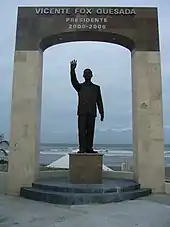
In October 2007, an announcement was made in the municipality of Boca del Río, Veracruz, that a 3-meter (10 ft) statue of Vicente Fox was to be erected to honor the former president. This aroused criticism from the opposition Party of the Democratic Revolution towards Boca del Río's mayor, who was affiliated with the same political party (PAN) as Fox.
The statue was put in place amidst protests on the dawn of 13 October 2007. The inauguration was to have been held on 14 October. Some hours after the statue was erected, a crowd of about 100 people (many of whom were members of the PRI, the political party opposed to Fox and which Fox had defeated in the 2000 election) brought the statue down by putting a rope around the statue's neck and pulling it down, damaging it.[129] The statue was put back in place for the inauguration, then taken away for repairs.[130]
PAN members accused Veracruz's governor, Fidel Herrera Beltrán, of "ordering the attack on the statue," and Fox called the governor intolerant. Others in the media argued that the installation of the statue was inappropriate, since former President Fox was facing allegations relating to an illicit enrichment scandal at the time.
Honors
 Collar of the Order of the Liberator General San Martín (Argentina)
Collar of the Order of the Liberator General San Martín (Argentina) Grand Star of the Decoration of Honour for Services to the Republic of Austria (Austria, 2005)[131]
Grand Star of the Decoration of Honour for Services to the Republic of Austria (Austria, 2005)[131] Grand Cross of the Order of Vytautas the Great (Lithuania, 14 January 2002)[132]
Grand Cross of the Order of Vytautas the Great (Lithuania, 14 January 2002)[132] Honorary Knight Grand Cross of the Order of St Michael and St George (United Kingdom)[133]
Honorary Knight Grand Cross of the Order of St Michael and St George (United Kingdom)[133] Collar of the Order of Isabella the Catholic (Spain, 8 November 2002)[134]
Collar of the Order of Isabella the Catholic (Spain, 8 November 2002)[134] Knight of the Royal Order of the Seraphim (Sweden, 22 October 2002)[135]
Knight of the Royal Order of the Seraphim (Sweden, 22 October 2002)[135]
Notes
Specific
- Vincent Mosco; Dan Schiller (2001). Continental Order?: Integrating North America for Cybercapitalism. Rowman & Littlefield Publishers. p. 111. ISBN 9780742509542.
- Charles Hauss (1 January 2018). Comparative Politics: Domestic Responses to Global Challenges. p. 391. ISBN 9781337554800.
- "El populismo de derecha" (in Spanish). Proceso. 10 September 2004. Retrieved 4 March 2018.
- "Revolución en México". El País (in Spanish). 4 July 2000. Retrieved 4 March 2018.
- "Who's Who". cdi-idc.com. CDI-IDC. n.d. Archived from the original on 2 December 2013. Retrieved 4 February 2019.
- Milner, Kate (2 July 2000). "End of era for all-powerful party". BBC News. Retrieved 28 November 2008.
- Manuel Pastor Jr. The Lost Sexenio: Vicente Fox and the New Politics of Economic Reform in Mexico. p. 136.
- "Con Estados Unidos a una sana distancia". The Washington Post. 3 March 2006. Retrieved 2 May 2010.
- "Vicente Fox's rocky first year as president of Mexico". The San Diego Union-Tribune. 13 December 2001. Retrieved 10 March 2018.
- "La Jornada Virtu@l". jornada.com.mx. n.d. Retrieved 4 February 2019.
- "Cuba - Castaneda - Mexico - Castro - Worldpress.org". worldpress.org. n.d. Retrieved 4 February 2019.
- Editorial Desk (7 April 2005). "Let Mexico's Voters Decide". The New York Times. Archived from the original on 10 April 2005. Retrieved 16 June 2008.
- Editorial desk (6 April 2005). "Decision on Democracy". The Washington Post. Archived from the original on 12 November 2012. Retrieved 15 February 2019.
- O'Grady, Mary Anastasia. Why Fox's Outrage? Chavez's Meddling in Mexico. The Wall Street Journal. (Eastern edition). New York, N.Y.: 18 November 2005. pg. A.17
- "Chavez renews trade pact attack". 20 November 2005. Retrieved 15 February 2019 – via news.bbc.co.uk.
- Avilés, Carlos; Zárate, Arturo (5 September 2006). "Proponen magistrados declarar Presidente electo a Calderón". El Universal. Retrieved 15 February 2019.
- "Se opone al plantón 65% en DF: encuesta". Carlos Ordóñez, El Universal, 14 August 2006.
- Diana Denham and the C.A.S.A. Collective (ed.). Teaching Rebellion: Stories from the Grassroots Mobilization in Oaxaca.
- "Solidaridad, Oportunidades y Prospera no disminuyeron la pobreza". Milenio (in Spanish). 7 July 2015. Retrieved 9 March 2018.
- es:CentroFox.org.mx
- archivo.eluniversal.com.mx/nacion/203190.html
- Delgado, Alvaro (8 April 2018). "Fox reitera su apoyo a Meade y afirma que no respaldará a Anaya". Proceso. Retrieved 27 June 2018.
- Find A Grave Database/accessed 26 January 2018/https://www.findagrave.com/memorial/171721405/joseph-louis-fox_flach
- Ancestry.com. Cincinnati, Ohio Directory, 1890–91 [database on-line]. Provo, UT, USA: MyFamily.com, Inc., 2000. Original data: Cincinnati, OH, USA: Williams & Co., 1890.
- Vicente Fox Quesada; Rob Allyn (2007). Revolution of Hope: The Life, Faith, and Dreams of a Mexican President. Viking. pp. 47–. ISBN 978-0-670-01839-0.
- "Vicente Fox". Archived from the original on 21 January 2010. Retrieved 27 June 2010.
- Tribune, Chicago (n.d.). "- Several articles about Mexican President Vicente..." Chicago Tribune. Retrieved 4 February 2019.
- "Fox a self-made man known for tart tongue". Boston Herald. 8 January 2017. Retrieved 4 February 2019.
- Reding, Andrew (Fall 1996). "The Next Mexican Revolution". World Policy Journal. 13: 63 – via ProQuest Central.
- Milner, Kate (3 July 2000). "Profile: Vicente Fox". BBC. Retrieved 4 June 2007.
- Biography of Vicente Fox Archived 18 September 2012 at the Wayback Machine
- "5 cosas que debes saber sobre Lilián de la Concha, ex esposa de Fox y vinculada al Cártel del Milenio". 23 October 2013. Retrieved 6 November 2016.
- BeleJack, Barbara (16 February 2001). "Live, from Guanjuato: It's President VICENTE FOX!". Texas Observer. Retrieved 4 June 2007.
- "Vicente Fox: President Elect of Mexico". 2000. Archived from the original on 7 March 2007. Retrieved 4 June 2007.
- Biography of Vicente Fox Archived 18 September 2012 at the Wayback Machine, United Nations (accessed 20 January 2010).
- John Ross, Fox, Inc., takes over Mexico dated March 2001, at globalpolicy.org. Retrieved 8 July 2017
- Marley, David F. (11 October 2019). Mexican Cartels: An Encyclopedia of Mexico's Crime and Drug Wars. ABC-CLIO. ISBN 978-1-4408-6476-6.
- Encyclopedia.com. Archived 2 October 2009 at the Wayback Machine
- "AMERICAS – Profile: Vicente Fox". Retrieved 6 November 2016.
- LaRaza.com. Archived 12 October 2007 at the Wayback Machine
- Foundation, Thomson Reuters. "Humanitarian – Thomson Reuters Foundation News". Retrieved 6 November 2016.
- Pastor, Manuel; Wise, Carol (2005). "The Lost Sexenio: Vicente Fox and the New Politics of Economic Reform in Mexico". Latin American Politics and Society. 47 (4): 135–160. doi:10.1111/j.1548-2456.2005.tb00331.x. ISSN 1531-426X. JSTOR 4490436.
- Capoza, Koren L. "Taking back the barrio". Retrieved 6 November 2016.
- "Profile: Vicente Fox". BBC News. 3 July 2000. Retrieved 27 May 2010.
- "Google Images". Retrieved 6 November 2016.
- "Google Images". Retrieved 6 November 2016.
- "Derrotan los ejidatarios a Fox: Cancela el aeropuerto en Texcoco". Proceso. 1 August 2002. Retrieved 27 January 2020.
- "Fox se reunirá con el ex presidente Bush en México". El Siglo de Torreón. Reuters. 8 May 2003. Retrieved 27 January 2020.
- "Office of the Historian, Foreign Service Institute". Retrieved 27 January 2020.
- "Mexico's Fox apologises to Castro". BBC News. 25 April 2002. Retrieved 3 November 2013.
- Marc Lacey (11 December 2009). "Top diplomats of Cuba and Mexico meet". The New York Times. Retrieved 3 November 2013.
- "Financial Times revela anomalías en las cuentas de Vamos México". La Jornada. Retrieved 27 January 2020.
- Vargas Elvira, Rosa. "Anuncia Marta Sahagún que ya no buscará ser consejera panista". La Jornada. Retrieved 27 January 2020.
- "López Obrador mantiene índices altos de aceptación, revela sondeo". La Jornada. Agence France-Presse. 8 January 2005. Retrieved 27 January 2020.
- Editorial Desk (7 April 2005). "Let Mexico's Voters Decide". The New York Times. Archived from the original on 10 April 2005. Retrieved 16 June 2008.
- Editorial desk (April 6, 2005). "Decision on Democracy". The Washington Post. Archived from the original on November 12, 2012. Retrieved June 16, 2008.
- La Jornada > Lunes 25 de abril de 2005
- Weiner, Tim. "Castro's Attack on Fox Places Cuban-Mexican Ties in Danger". The New York Times.
- "Mexican leader criticized for comment on blacks", CNN, 15 May 2005.
- "Vuelve Fox a incurrir en error cultural en discurso", El Universal, México.
- "México: Congreso pregunta por Juárez". BBC Mundo. 31 May 2005. Retrieved 19 September 2019.
- "News in English, 05-05-31". Hellenic Radio (ERA). 31 May 2005. Retrieved 19 September 2019.
- "Evo pide a Fox que no trate de humillarlo por presunta negativa a vender gas a México" 24 March 2008.
- "Bungling of Ianiero murder case tied to Mexican tourist trade: lawyer". CBC News. 17 July 2009. Retrieved 4 February 2019.
- Suspects in Ianiero murder likely Canadian: Fox 29 March 2006
- A timeline of the case 26 July 2006 Archived 14 March 2013 at the Wayback Machine
- "El Porvenir – Nacional – 'Puedo decir cualquier tontería... ya me voy: Fox". 28 September 2007. Archived from the original on 28 September 2007. Retrieved 4 February 2019.
- "Cancela Fox, porque son 'tiempos democráticos', el desfile deportivo del 20 de noviembre; PRI considera que cedió la plaza a López". 24 March 2008.
- Fox incurre en error al felicitar a Vargas Llosa. 7 October 2010.
- Ortega Avila, Antonio. "La revolución fracasada de Fox". El País. Retrieved 30 November 2018.
- "Sexenio foxista, entre los escándalos y la decepción". El Siglo de Torreón. Retrieved 30 November 2018.
- Batres Guadarrama, Marti. "Vicente Fox, el fracasado". La Jornada. Retrieved 30 November 2018.
- Cacho, Alejandro (5 June 2018). "¿Queremos candidato o presidente?". El Heraldo de México. Retrieved 12 January 2020.
- Russell, Philip (2011). The History of Mexico: From Pre-Conquest to Present. Routledge. p. 593. ISBN 9781136968280.
- Beltran, Ulises. "Zedillo y Fox los ex presidentes de México más reconocidos". Imagen Radio. Retrieved 21 February 2020.
- "One Young World Archives – Telefonica". Retrieved 6 November 2016.
- Wall, Allan. "Fox Redefines the Role of Past Mexican Presidents" (accessed 20 January 2010).
- "Centro Fox » (Español) Vicente Fox participa en cumbre mundial One Young World 2014: "La erradicación de la corrupción tiene que empezar con la educación"". Retrieved 6 November 2016.
- One Young World (17 October 2014). "President Vicente Fox of Mexico Introduces Himself". Retrieved 6 November 2016 – via YouTube.
- Fox, Vicente. "Drugs, Money and Morality". IAI. Retrieved 29 January 2014.
- Hampton, Justin. "President Vicente Fox: The HIGH TIMES Interview". High Times. Retrieved 18 February 2014.
- Fox, Vicente (17 February 2014). "For Mexico, legalization is freedom". The Globe and Mail. Toronto. Retrieved 18 February 2014.
- "Venezuela declara a Vicente Fox persona 'non grata'". Excélsior (in Spanish). 17 July 2017. Retrieved 20 July 2017.
- "Venezuela declara 'persona non grata' a Vicente Fox". Milenio (in Spanish). Retrieved 20 July 2017.
- "Vicente Fox es declarado persona 'non grata' en Venezuela". elfinanciero.com.mx. Retrieved 21 July 2017.
- "Vicente Fox responde a Venezuela tras ser nombrado". Publimetro México (in Spanish). Retrieved 21 July 2017.
- Blood, Michael R. (18 June 2018). "Former Mexico President Vicente Fox joins High Times board". AP News. Retrieved 10 January 2021.
- Schreckinger, Ben (4 September 2020). "How Legal Weed Destroyed a Counterculture Icon". Politico. Retrieved 10 January 2021.
- "Immigration". Archived from the original on 29 September 2015. Retrieved 6 November 2016.
- "Former Mexican President to Trump: 'I'm not going to pay for that fucking wall'". Retrieved 21 July 2017 – via YouTube.
- "Former Mexican President to Donald Trump: 'I'm not going to pay for that fucking wall'". Retrieved 6 November 2016.
- "Donald J. Trump on Twitter". Retrieved 6 November 2016.
- "Vicente Fox apologizes to Trump for wall outburst". Retrieved 6 November 2016.
- "Vicente Fox Quesada on Twitter". Retrieved 6 November 2016.
- Wright, David. "Former Mexican President apologizes for Trump invitation". CNN. Retrieved 6 November 2016.
- "Vicente Fox on Trump: 'Please wake up, America'". Retrieved 6 November 2016.
- "Donald Trump keeps asking foreign leaders for money. The latest: Vicente Fox". Retrieved 6 November 2016.
- "Vicente Fox Quesada on Twitter". Retrieved 6 November 2016.
- "Vicente Fox Quesada on Twitter". Retrieved 6 November 2016.
- "Vicente Fox Quesada on Twitter". Retrieved 6 November 2016.
- Nelson, Rebecca (19 September 2016). "Vicente Fox, Former President of Mexico, Has a Few Thoughts on Donald Trump".
- Fox, Vicente (9 November 2016). "If Trump doesn't want to work with Mexico, it's America's loss".
- Seipel, Brooke (6 January 2017). "Vicente Fox to Trump: We won't pay for 'that f----- wall'". TheHill. Retrieved 4 February 2019.
- "Vicente Fox Quesada on Twitter".
- Hensch, Mark (11 January 2017). "Vicente Fox: Trump ushering in 'a new era of dictatorship'".
- "Vicente Fox Quesada on Twitter".
- Cooper, Anderson. "Vicente Fox: Wall is stupid, waste of money". CNN.
- "Former Mexican President Vicente Fox Tears into Donald Trump Over DACA". huffpost.com. Retrieved 7 September 2017.
- VicenteFoxQue Twitter 3 November 2017
- YouTube: Super Deluxe "Vicente Fox is Running for President of the United States", 7 September 2017.
- Clock ticking for Allyn on Fox book | Dallas Morning News | News for Dallas, Texas | Arts & Entertainment. Archived 30 September 2007 at the Wayback Machine
- Fox reaparece en Los Ángeles; entre protestas, defiende logros – El Universal – México
- "Former Mexican President Vicente Fox Debates Immigration Issue with Bill". Fox News Channel. 10 October 2007.
- Entrevista con Vicente Fox causa polémica – Noticias – KVEA Los Angeles. Archived 16 July 2011 at the Wayback Machine
- Polémica por gira de Fox. Archived 22 October 2007 at the Wayback Machine
- "Vicente Fox: Bush a "windshield cowboy" who's scared of horses – Corrente". Retrieved 6 November 2016.
- "Login Grupo Reforma". Retrieved 6 November 2016.
- "SignOnSanDiego.com > News > Mexico – Fox gets award for reform in Mexico". signonsandiego.com. n.d. Retrieved 4 February 2019.
- Centrofox.org.mx. Archived 28 September 2007 at the Wayback Machine
- MySA.com: Metro | State. Archived 29 September 2007 at the Wayback Machine
- "Login Grupo Reforma". Retrieved 6 November 2016.
- "Login Grupo Reforma". Retrieved 6 November 2016.
- "Fox looks to cement his place in history – The San Diego Union-Tribune". signonsandiego.com. n.d. Retrieved 4 February 2019.
- . Archived 12 October 2007 at the Wayback Machine
- Fox Center. Archived 28 September 2007 at the Wayback Machine
- "Former Mexican President, Vicente Fox, Pushes Mexico To Become Technology Hub". Retrieved 7 September 2017.
- "UST Global in pact with Centro Fox of Mexico". The Hindu. Chennai, India. 18 July 2012.
- Portail d'informations Ce site est en vente!. Archived 25 July 2011 at the Wayback Machine
- "Protestors Tear Down Vicente Fox Statue". CBS News. Retrieved 7 September 2017.
- La Prensa Latina » Blog Archive » Derriban estatua de Vicente Fox. Archived 4 June 2008 at the Wayback Machine
- Bundeskanzler (23 April 2012). "Reply to a parliamentary question regarding medals and decorations to former domestic and foreign government officials" (PDF) (Anfragebeantwortung) (in German). Letter to Barbara PRAMMER. p. 1711. Retrieved 19 March 2019.
- Lithuanian Presidency website, search form
- "HONORARY KNIGHTHOODS AWARDED 1997-2006". UK Parliament Data. Retrieved 8 February 2021.
- "Boletín Oficial del Estado" (PDF). boe.es. n.d. Retrieved 4 February 2019.
- "2002/27" (PDF). n.d. Retrieved 6 November 2016.
General
- Schmidt, Samuel (2000). México encadenado: El legado de Zedillo y los retos de Fox. México, D.F.: Colibrí.
External links
| Wikiquote has quotations related to: Vicente Fox |
| Wikimedia Commons has media related to Vicente Fox. |
- Vicente Fox website during his Presidency
- Vicente Fox Museum and Library
- Extended bio and presidential tenure, by CIDOB Foundation
- Vicente Fox Interview on The Hour with George Stroumboulopoulos
- Vicente Fox at IMDb
- Appearances on C-SPAN
- Miguel Angel Mancera Espinosa
| Chamber of Deputies (Mexico) | ||
|---|---|---|
| Preceded by Héctor Hugo Varela Flores |
Member of the Chamber of Deputies of Mexico for the 3rd district of Guanajuato 1988–1991 |
Succeeded by Luis Arturo Torres del Valle |
| Party political offices | ||
| Preceded by Diego Fernández de Cevallos |
PAN presidential candidate 2000 |
Succeeded by Felipe Calderón |
| Political offices | ||
| Preceded by Ernesto Zedillo |
President of Mexico 2000–2006 |
Succeeded by Felipe Calderón |
| Preceded by unknown |
Co-President of Centrist Democrat International 2006–present |
Incumbent |
| Diplomatic posts | ||
| Preceded by Jiang Zemin |
Chairperson of APEC 2002 |
Succeeded by Thaksin Shinawatra |
